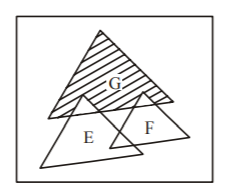Question
Let $${E^c}$$ denote the complement of an event $$E$$. Let $$E,\,F,\,G$$ be pairwise independent events with $$P\left( G \right) > 0$$ and $$P\left( {E \cap F \cap G} \right) = 0.$$ Then $$P\left( {{E^c} \cap {F^c}|G} \right)$$ equals :
A.
$$P\left( {{E^c}} \right) + P\left( {{F^c}} \right)$$
B.
$$P\left( {{E^c}} \right) - P\left( {{F^c}} \right)$$
C.
$$P\left( {{E^c}} \right) - P\left( F \right)$$
D.
$$P\left( E \right) - P\left( {{F^c}} \right)$$
Answer :
$$P\left( {{E^c}} \right) - P\left( F \right)$$
Solution :
We have

$$\eqalign{ & \because \,E \cap F \cap G = \phi \cr & P\left( {{E^c} \cap {F^c}/G} \right) = \frac{{P\left( {{E^c} \cap {F^c} \cap G} \right)}}{{P\left( G \right)}} \cr & = \frac{{P\left( G \right) - P\left( {E \cap G} \right) - P\left( {G \cap F} \right)}}{{P\left( G \right)}} \cr & \left[ {{\text{From ven diagram }}{E^c} \cap {F^c} \cap G = G - E \cap G - F \cap G} \right] \cr & = \frac{{P\left( G \right) - P\left( E \right)P\left( G \right) - P\left( G \right)P\left( F \right)}}{{P\left( G \right)}} \cr & = 1 - P\left( E \right) - P\left( F \right) \cr & = P\left( {{E^c}} \right) - P\left( F \right) \cr & \left[ {\because \,E,\,F,\,G{\text{ are pairwise independent}}} \right] \cr} $$
We have

$$\eqalign{ & \because \,E \cap F \cap G = \phi \cr & P\left( {{E^c} \cap {F^c}/G} \right) = \frac{{P\left( {{E^c} \cap {F^c} \cap G} \right)}}{{P\left( G \right)}} \cr & = \frac{{P\left( G \right) - P\left( {E \cap G} \right) - P\left( {G \cap F} \right)}}{{P\left( G \right)}} \cr & \left[ {{\text{From ven diagram }}{E^c} \cap {F^c} \cap G = G - E \cap G - F \cap G} \right] \cr & = \frac{{P\left( G \right) - P\left( E \right)P\left( G \right) - P\left( G \right)P\left( F \right)}}{{P\left( G \right)}} \cr & = 1 - P\left( E \right) - P\left( F \right) \cr & = P\left( {{E^c}} \right) - P\left( F \right) \cr & \left[ {\because \,E,\,F,\,G{\text{ are pairwise independent}}} \right] \cr} $$